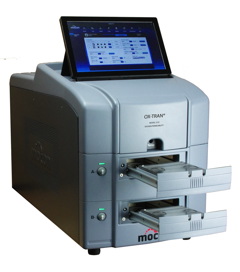MOCON Offers Oxygen Permeation Analyzer
- Published: December 03, 2015
MINNEAPOLIS, MN | MOCON, an international provider of instruments and services for testing, measuring, and analyzing invisible gases, announces the new OX-TRAN Model 2/22 L, which has been engineered to accurately and quickly measure oxygen transmission rate (OTR) for a wide range of high-barrier materials and packages. 
It is said to be ideally suited for food, pharmaceutical, medical device, film converters, and resin producers who want to push the shelf life envelope by reducing oxygen permeation of packages.
Company says test times are reduced significantly depending on barrier levels, and the repeatability specification has been improved 2.5x over the OX-TRAN Model 2/21 L.
“By obtaining more precise data about oxygen transmission through packaging materials, companies will be better able to predict, and in some cases, extend their product shelf life, says Karsten Kejlhof, VP sales and marketing, package testing and permeation, MOCON. “The information also will be a useful in helping to manage material costs versus shelf life expectations.”
The OX-TRAN Model 2/22 L is designed to operate at a lower cost of ownership by eliminating several common maintenance expenses. The install wizard allows for step-by-step user installation and the gas-saver feature automatically reduces consumption when the system is idle. In addition, many safety features have been added to increase component lifetime.
Automation features include relative humidity (RH), temperature, pressure, flow, and testing. When testing film with unknown characteristics, the auto test feature determines the optimal parameters and conducts the test to completion. Remote viewing and control from anywhere in the world is possible with the connectivity options.
Automatic sequential testing benefits R&D situations where film testing capabilities at various RH and temperature levels are desirable. This feature allows the operator to establish up to ten different RH and temperature conditions in a single test setup and then automatically run all tests without further operator input.
Reportedly, companies that change from wet to dry testing also will benefit because conditions now can be altered with a simple click. Overall set-up and testing times will be reduced because operators no longer need to empty the reservoir nor wait for the system to dry.
This email address is being protected from spambots. You need JavaScript enabled to view it.




